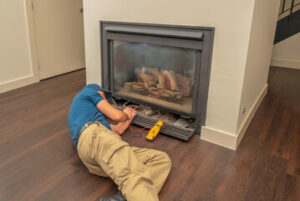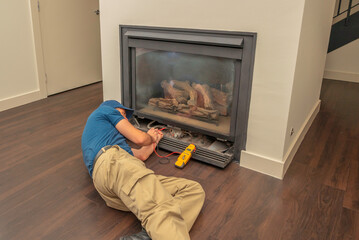A fireplace is a cozy place to sit on a cold evening with family and share stories. But when your fireplace isn’t working properly, it can destroy those moments.
Look for signs of damage like a crack in your safety glass screen, which could allow dangerous chemicals to leak into your home. Other issues include gas smells and a lack of flames. If you need some professional help, you may contact Fireplace Repair West Chester PA.
Rust is a common problem in fireplaces, especially in older systems. Metal chimney components like the cap and chase cover, as well as the flue liner, are prone to corrosion due to their exposure to moisture over long periods of time. The rust can eventually cause structural damage and lead to leaks. If you see rust on the chase cover or firebox, it is important to call a professional to have the system inspected right away.
The first step is to clean the rust off the fire pit. Using gloves and protective coverings, vacuum or sweep the area to remove large particles. Next, use a wire brush or Scotchbrite pad to loosen the rust from the surface. After this, you can scrub the rust off with steel wool. Make sure you rinse the surface thoroughly after you are done to prevent further damage. You can also use a paste made from baking soda and water to slowly loosen the rust before you scrub it off. After you have removed the rust, use a rust remover to keep it from returning.
If you have a cast iron fireplace insert, you will need to consult a certified welder to restore the unit to its original appearance. This will require gradually heating the cast iron to high temperatures and then cooling it down before welding any cracks. This will take several hours and may cause odors and smoke detectors to go off.
If you notice that your fireplace is not lighting or the flames are erratic, it is likely a problem with the burner orifice, which is the opening in the tubes that send gas to the combustion chamber. This could be caused by a buildup of creosote or other deposits. You should contact a professional chimney technician to check the orifice for problems and repair it as needed.
Soot
There is no denying that fireplaces produce soot, and if it isn’t cleaned regularly, it can build up and leave lasting stains on the surrounding brick. Soot isn’t just unsightly, though; it can be dangerous to home occupants as well. Soot is made up of carbon particles that aren’t fully combusted, which means that when inhaled, these particles can affect your health. They can cause a variety of breathing problems, including bronchitis and asthma, and even increase your risk of certain cancers.
Soot buildup in gas fireplaces may be caused by several things. First, misaligned fire logs can block the flame path and result in an incomplete burn that produces soot. Secondly, soot can accumulate on gas burner ports when they are clogged with residue from improper burning. Soot may also be produced if the gas regulator feeding your fireplace isn’t adjusted correctly. Having an HVAC expert check your fireplace for these issues can help you avoid soot buildup in the future.
To remove soot, start by saturating the area with water. This will prevent the cleaning solution from drying out as you work on it. Next, use a vacuum to remove the majority of the soot. You can then soak the ceramic logs in a mixture of vinegar and lukewarm water. You should dry the logs afterwards to keep them from cracking or warping.
Finally, you can wipe down the remaining soot with a cloth or cotton swab and a cleaner such as borax or ammonia, as long as it is permitted in your fireplace’s manual. Make sure to follow all of the instructions for your cleaner thoroughly to avoid voiding any warranties or damaging your fireplace.
Shaling
A gas fireplace with a working pilot light is one of the most enjoyable ways to warm up on a cold night. The kids can sit around the fire and tell stories while you enjoy a cup of hot cocoa. So, if you go to start the fireplace on a cool evening only to find it will not turn on, this could be an indication that the system has a problem. The problem could be as simple as flipping the wall switch on and off or as complicated as a clogged flame sensor, a blocked gas valve, a broken thermopile, or faulty wiring. A technician will be able to determine the cause and fix it.
If you find that your chimney and fireplace have become unsafe or don’t work correctly, this may be a sign of serious damage and neglect. Our SuperTech technicians can provide you with a thorough inspection and bring your chimney up to code.
Despite your best efforts to keep it clean, creosote can sometimes build up in the damper hinge of your fireplace. This problem can be solved by thoroughly cleaning the damper and lubricating it with a rust-preventative, penetrating oil such as WD-40.
Another sign that your fireplace is not working properly is a strong, pungent odor of natural gas, which can be dangerous. If you notice these odors, call your utility company immediately and have a professional examine the system. They may also recommend the installation of a new flue liner.
Broken Flue Tiles
Most masonry chimneys were built with clay flue tiles, and over time, these can crack and become damaged. This is a problem that should be repaired by a professional chimney sweep as soon as it is detected. Cracks, gaps, and spalling can allow gases and chemicals like carbon monoxide to seep into your home. These harmful gases are not only dangerous to your family but can also deteriorate the brick and mortar of your chimney over time. It is also a fire hazard, as the cracks can allow creosote to enter the chimney. Creosote is highly flammable and can damage your roof as well as your chimney.
Chimneys should be inspected every fall to ensure that they are free of cracks and gaps in the flue tile liner. This should be done with a flashlight and safety glasses to ensure that all areas are being checked. If you have cracks or gaps in your flue tiles, it is a good idea to have your chimney relined before the heating season begins.
There are several ways to repair cracked flue tiles. If the tile can be accessed easily with a hammer, it can be broken apart and replaced with a new one using cement to hold it in place. If there are many cracks and gaps, it may be necessary to have your entire chimney relined with a stainless steel liner. This system is dropped down the chimney to cover the old clay tiles, and since it is one piece, it will not crack as easily as the existing tiles. It is also less expensive than a full chimney teardown.
Burner Orifice
The burner orifice is a brass fitting with an appropriately-sized hole for the flow of natural gas or propane. It controls the size and intensity of the flame in a fireplace, as well as the gas flow to other parts of the stove or fireplace itself. It also determines the overall Venturi effect of the fire.
When the orifice is clogged, it won’t deliver enough fuel to the burner tube for proper combustion. It is important to check and clean the orifice regularly, as it can easily be blocked by dirt.
An orifice that is too large can also cause problems. This is because the cone of gas that exits the orifice won’t match the shape of the burner flare, and it will create too much of a vacuum to pull in sufficient air.
If the orifice is too small, it will have the opposite problem. The cone of gas will have trouble matching the shape of the burner flare, and it won’t be able to create a strong enough vacuum to pull in adequate air for combustion.
It is important to know that the relationship between pressure and orifice size is a quadratic equation, not a linear one. Double the area of the orifice, and you will quadruple the BTU potential.
The orifice size must be correct for the type of gas being used, so it’s important to consult a burner orifice chart to ensure the orifice is correctly sized. Propane orifices are smaller than natural gas orifices. Use the chart to find the size that will fit your fireplace, and remember to replace the orifice when you change your gas source. Our glassblower friend had to do this after he switched from natural gas to propane.

